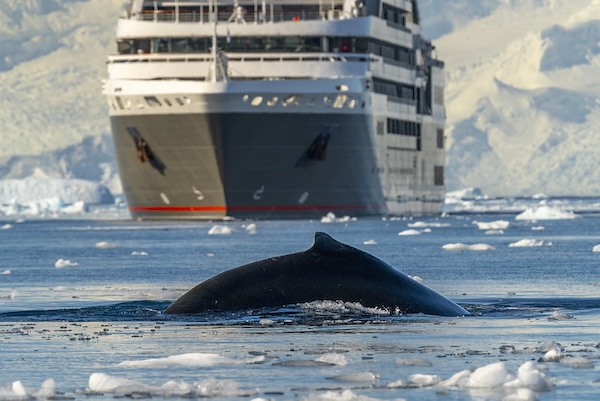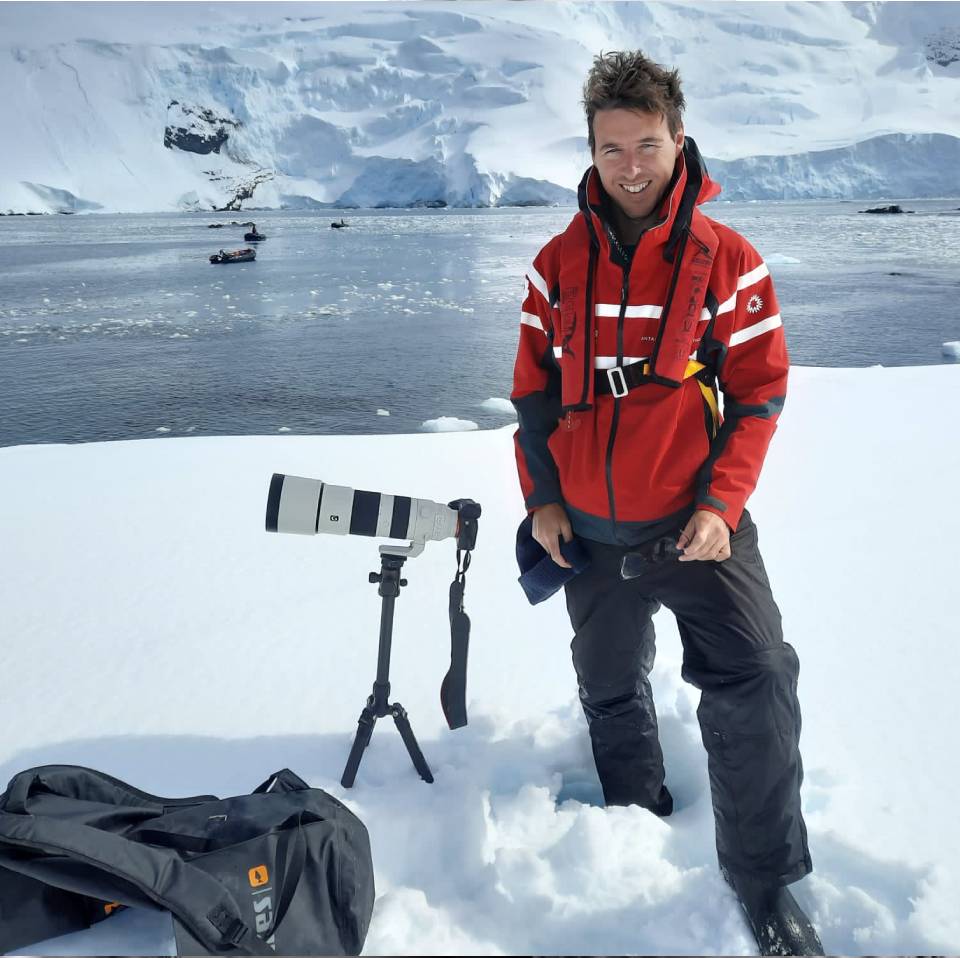If you’re anything like me, one of the biggest reasons you dream of heading to Antarctica is the wildlife — and for many, whales top that list.
There’s something about seeing these massive, graceful creatures in the wild, framed by jagged icebergs and endless white horizons, that sticks with you for a lifetime.
Over my years sailing south to Antarctica, I’ve learned a few tricks to maximise whale sightings.
Last season I was lucky enough to see a breaching humpback from the ship (see picture below).
If you’re hoping to have those magic moments with humpbacks, minkes or even a passing orca pod, here’s how to give yourself the best possible chance.
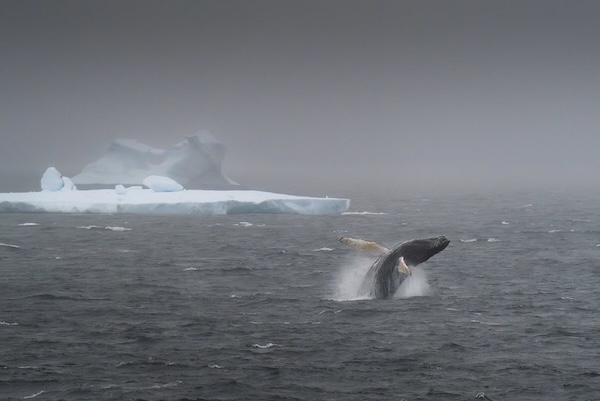
Travel Late in the Season — It’s Whale Heaven
This is my number one tip, and it’s something not everyone realises before booking their trip.
The Antarctic season runs from November to March, and while every part of the season has its highlights, late February to mid-March is the absolute best time for whale sightings.
During these months, the whales have migrated south to feed in the rich Antarctic waters.
Massive krill blooms attract humpbacks in huge numbers, and you’re far more likely to encounter multiple sightings in a single day.
I remember one trip in March where we saw so many humpbacks around the ship, we literally had to alter our course because they kept surfacing right in front of us.
The water was glassy, the light golden, and I still rate it as one of the most surreal evenings of my life.
If whales are a priority for you, aim for a departure in those final few weeks of the Antarctic summer. You’ll thank yourself later.
Please read our full page on the best time to visit Antarctica here
Spend as Much Time as Possible on Deck
It sounds obvious, but you’d be amazed how many people retreat indoors between landings, missing incredible wildlife moments right outside.
Antarctica isn’t a destination to visit through a window. Some of my most memorable whale encounters happened while casually leaning on the rail, coffee in hand, not during an official landing or zodiac excursion.
Whales often surface unpredictably — sometimes in the middle of the bay, other times just metres from the ship. I’ve lost count of how many times we’ve had to abandon whatever we were doing because someone on deck shouted “Whale!” and a crowd quickly gathered.
Bring binoculars. Even if you’re a photographer (and trust me, I get it — I’m usually carrying half a camera store on my back), having a decent pair of binoculars makes a world of difference.
You’ll be able to pick out whales at a distance: the telltale blows and flukes slicing the water.
My advice? Find yourself a sheltered corner of the observation deck, settle in between activities, and just scan the horizon.
The Antarctic wilderness has a way of rewarding patience.
For a list of the best Antarctic bincolculars, see our article here
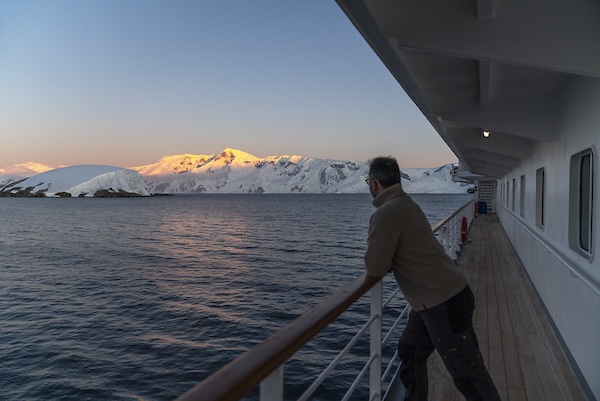
Pick an Itinerary That Stays in the Peninsula Longer
Not all Antarctic itineraries are created equal. Standard trips dart down to the peninsula for three or four days before heading back across the Drake Passage, while others. such as the Circle trips, linger for longer, sometimes 7–9 days exploring the peninsula and getting further south.
The more time you spend in Antarctic waters, the higher your chances of whale encounters. It’s a simple numbers game.
Plus, spending extra days gives you the flexibility to make the most of calm weather days for zodiac cruises, when the conditions are ideal for spotting whales at sea level.
I’ve found that smaller ships also tend to be better for wildlife viewing — not only are they more manoeuvrable when following a pod of whales, but you’re more likely to get onto the zodiacs quickly when something special is spotted.
Check out all the Antarctic itineraries on this page.
Zodiac Cruises: Be Ready to Pivot
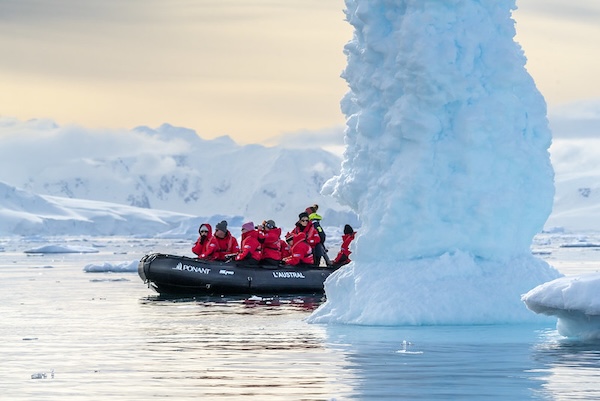
Speaking of zodiacs — whale encounters on the water are something else. There’s nothing quite like being in a tiny inflatable boat when a humpback dives nearby or a minke surfaces unexpectedly.
On one cruise near Wilhelmina Bay (one of the region’s best whale spots), we were cruising around a group of icebergs when someone pointed out a blow in the distance.
Within 10 minutes, we were surrounded by five humpbacks, lazily feeding and spy-hopping beside the zodiacs. Cameras down, mouths open — it was one of those ‘life list’ moments.
The key here is flexibility. If your expedition leader announces a last-minute zodiac cruise because whales have been spotted nearby, drop everything and go.
Even if it’s cold, snowing, or dinner’s about to be served — trust me, the whales win every time.
Learn more about zodiacs here.
Stay Up Late
Antarctic summer means long days, and in peak whale season, the evenings often deliver some of the most dramatic wildlife encounters.
The soft evening light, mirror-calm seas, and golden-hour glow over the icebergs make it prime time for spotting whales.
On my last trip, I made a habit of heading to the aft deck around 10pm each night with a drink and my binoculars. More often than not, it paid off with sightings of humpbacks feeding or orcas cruising along the ice edge.
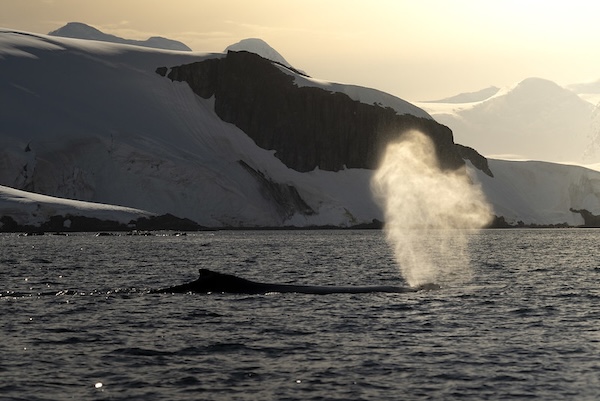
In Summary
-
If whales are high on your Antarctic wishlist, here’s your playbook:
-
Travel in late February or March for the best chance of sightings.
-
Spend as much time on deck as possible, binoculars at the ready.
-
Pick an itinerary that maximises time in the Antarctic Peninsula.
-
Be ready to join spontaneous zodiac cruises when sightings happen.
-
Stay up late and watch the calm evening waters — magic often happens when most people have gone to bed.
Antarctica is unpredictable by nature, and no two trips are the same. But by following these tips and embracing a little patience, you’ll give yourself the very best shot at those unforgettable whale encounters.
And when it happens — when a humpback arches its tail into the air against a backdrop of jagged icebergs and polar sunset — you’ll know it was all worth it.
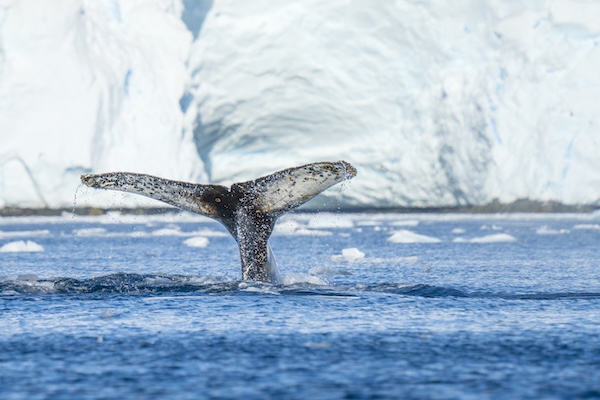
Final note
If you do manage to snap some great pictures of whales, don't forget to submit them to the citizen Science program - HappyWhale!
Happywhale is a citizen science platform that uses AI and photo-identification to track individual whales and marine mammals worldwide.
People can upload their whale photos, and the system matches them against a global database to identify individual animals and track their movements.
It helps researchers, conservationists, and travelers contribute valuable data to marine science while fostering public engagement with ocean wildlife.
Last year, I was lucky enough to photograph a whale that had yet been identified, and so I was given the opportunity to name it! The picture I took is the one you can see above.

